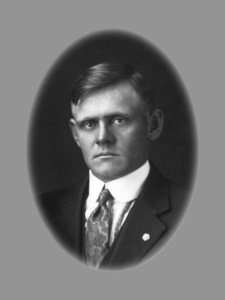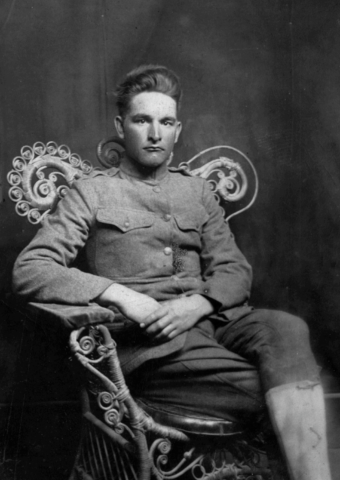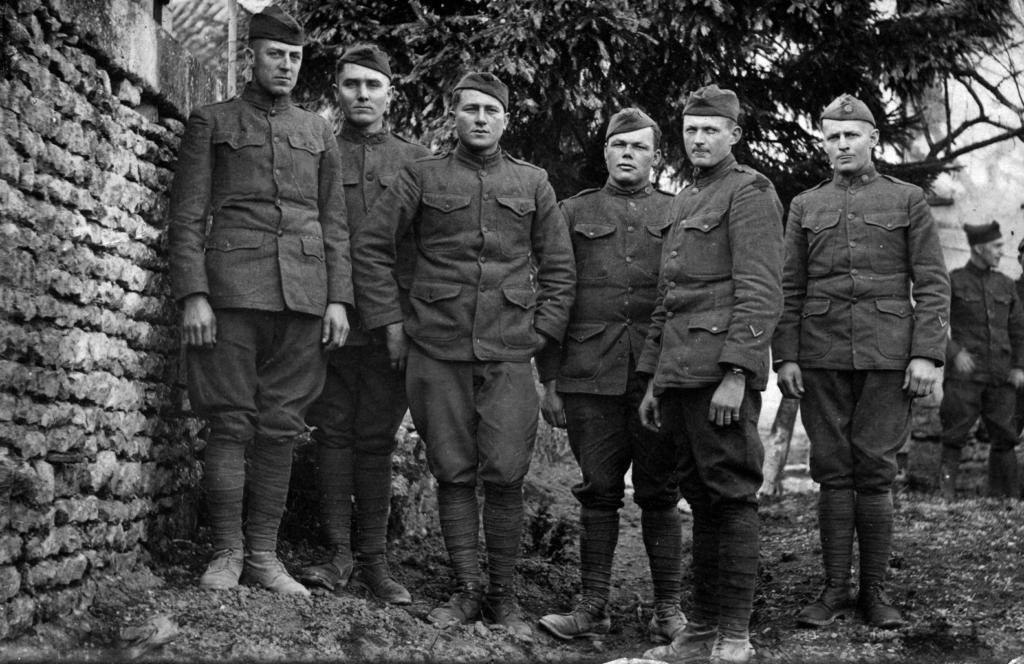
SRHS
Steamboat Rock Historical Society
WORLD WAR...AND THE GREAT DEPRESSION
WORLD WAR...AND THE GREAT DEPRESSION
Steamboat Rock has a long list of veterans of what would become known as The First World War.
It would be the most costly war ever seen. Some 10 million men were killed, 20 million wounded, and whole regions laid waste.
On June 5, 1917, 89 men from clay township had to register for the draft. Everyone between 21 and 31 was required to register.
In the course of this war we lost but a few and some were scarred by wounds both physical and emotional.
Hie G. Folkerts was one who was wounded in the war. He was 20 years old when war in Europe was declared by Germany, and the invasion of France began on August 3, 1914. The previous July the heir apparent to the Austrian throne was assassinated. England, France, and Russia formed an alliance, and they were opposed by Germany and Austria who had joined forces. By October, trench warfare and the long stalemate known as “World War,” began.
Gradually, one country after another was drawn into the conflict until at last the United States entered the war on the side of the “Allies.” This was brought largely because of unrestrained German submarine warfare. International law clearly stated that all neutral ships were to be respected and have the freedom of the sea lanes. But, Germany brutally ignored these rules of war. Vessels of every kind, no matter what their flag or nation, were fired upon and sent to the bottom of the sea without warning. Even hospital ships carrying relief to the stricken people of Belgium, were sunk. Among the ships sunk were also ships that carried American citizens. The United States entered the war on April 6, 1917 when President Wilson asked Congress for a declaration of war against Germany. Enlistment in Iowa had steadily increased during the three years of the war in Europe. Now they soared. By July, 1917, it is said that more than 10,000 Iowa boys had left homes, farms, and colleges and volunteered for service.
Iowa’s famous “Fighting 168th” the 168th Regiment of the Rainbow Division became famous in the history of World War I. The 42nd Division was created by the War Department in October, 1917, and later renamed the Rainbow Division. Iowa was represented in the Rainbow Division by the Third Iowa Infantry, later renamed the 168th U.S. Infantry.
The 168th went to France in December, 1917, and first saw action the following February. When the tide of battle was at last turned, the 168th was leading the counteroffensives; and their record of valor is a proud chapter in the military history of the state of Iowa. They fought with outstanding bravery, and paid a terrific price in wounded and dead at Chateau Thierry, Saint-Mihiel, Argonne Forest, the Lorraine front, and at Sadan.
My great uncle Hie G. Folkerts, entered the army on September 17, 1917, to join the war against his fathers homeland.
With the Americans in the war, several important battles were instrumental in bringing the war to an end. At Cantigny, France, American troops achieved the first clear cut American Victory. At ChateauThierry, Americans helped block a German advance. In the Battle of the Marne, American and French troops drove the Germans far back, making the turning point of the war. At St. Mihiel, American troopes mounted the first distinctly American offensive and captured the town.

Hie G. Folkerts
It was in the battle of St. Mihiel, that Hie became one of the 20 million wounded. As he described it, he was laying on his stomach, when next thing he knew he was lying on his back looking up at the sky. Hie had been seriously wounded in the left side.
He would be in the hospital in France for some time, well past the end of the war, which came on November 11, 1918. While in the hospital, word came to him that his mother had passed away.
After leaving the hospital in France, Hie was returned to this country and was taken to Ft. Sheridan, where he spent more time in the hospital, continuing to recuperate.
Hie received a Honorable Discharge, because of wounds received in action of campaign in February of 1920.
The final death toll of 3,578 Iowans out of over 114,000 men in service in World War I, brought sorrow and loneliness to thousands of Iowa parents, grandparents, sisters, wives and children.
At home, the people who could not serve on the battle fronts were also doing their part. The American Red Cross began its work immediately after the declaration of war when President Wilson created a Red Cross War Council. In June of 1917 Iowa led all states in the number of active chapters.
Ernestena Gast was a German immigrant who came to Steamboat Rock with her mother when she was sixteen years old. Ernestena married William Hartmen. She had had a deprived life in Germany and therefore deeply appreciated the privilege of living in the United States. During World War I she was chairperson of the local Red Cross unit which wrapped bandages, knit helmets and scarves for “our boys over there”.
On November 11, 1918, the Armistice came. War was over. It was a Monday morning at and early hour word reached Steamboat Rock people were awakened by the blowing of whistles and ringing of church bells. In a very short time the streets were lined with people, all rejoicing at the news that the war was over and the boys were coming home. Bands marched through the streets of every town and city, and their stirring music was accompanied by the cheers of people gone wild with joy. The community had paid a great price but could hold her head high with pride, even though many hearts were bowed with grief.
The following list includes only the names of those from Steamboat Rock that served in World War I that are buried in the Steamboat Rock Cemetery.
WORLD WAR I VETERANS
Charles F. Hoover 1894-1919
Ellis D. Willis 1896-1923
Gustave H. Ruppelt 1893-1925
Phillip Williamson 1895-1925
Louis E. Hitzel 1887-1929
Warren Lambert 1893-1945
Herman Ruppelt 1887-1946
Edward A. Ruppelt 1891-1948
Willard J. Caldwell 1878-1949
Oliver J. Hathaway 1890-1952
Henry Frerichs 1896-1954
Orlo Hartman 1900-1957
Hie G. Folkerts 1893-1959
Harry Robinson 1895-1958
John Howard 1894-1960
Harold Hartman 1900-1961
Henry Rose 1892-1966
Ernest Ruppelt 1896-1966
Hie H. Folkerts 1894-1971
Earl C. Wickham 1892-1973
Ben J. Eilers 1897-1974
George Potgeter 1897-1975
George H. Hoover 1889-1971
John C. Gast 1895-1977
Clerence E. Hutzel 1891-1978
Sophie Rowen* 1899-1981
Raymond Karsjens 1894-1981
Michael Finger 1893-1983
Web Folkerts 1996-1987
*nurse

Hie H. Folkerts, also suffered injuries in World War I.
Mildred Dunn Lepper in her book, Tell Me About the Old Days, Grandma, gives account of the end of the war when she came to Steamboat Rock. “It was about the middle of summer in 1918 that I came to live in Steamboat Rock, Iowa. There was much evidence of patriotism, for our country was still at war. People hung out their flags and brought them in before the sun went down. They must never be left out in the rain. Homes from where a soldier boy had left for the army or navy had a “service flag” proudly exhibited in a window – a square white flag with a red border and a blue star for each boy in the service. Some ladies went as nurses, also. The Henry Potgeter family had four stars in their service flag – one for each of three sons and one for a daughter, Sophia, who served as a nurse in France.”
“On Saturday nights there were usually band concerts and singing. A flat hay rack served as a stage, and sometimes little Beatrice Harris, my second cousin, a pretty, five year old, sang, “Johnny Get Your Gun”, or “Good bye, ma! Good bye, pa! Good bye mule with your old heehaw!”. There were many popular songs during World War I. Some were funny, some sad. We learned them all. We had great dislike of a fellow in Germany called “Kaiser Bill”, and we could name who our allies were. Germany was the enemy”
“My memory goes back to November 11, 1918 as though it were yesterday I was ten years and eight months old. We awoke that morning to the sound of bells ringing and whistles blowing. The whistles were blowing over in Eldora, our county seat town five miles to the south. Our little restaurant was directly across the street from what was then the Congregational church. A block east was the Presbyterian, and east of that was the Baptist. Their bells were all ringing at once, and the Congregational rang all day Even I took a turn making it ring, all seventy-odd pounds of me pulling on the rope. The whole town went wild with joy The awful “war to end all wars” was over. Now the boys could come home. Grown-ups were saying, “This day will be celebrated forever, and there will be fireworks every year, just like on the Fourth of July” They felt sure there were not going to be any more wars.”

Gustave Herman Ruppelt third from the left and in the inset served in WWI and is pictured here with some of his fellow soldiers.
“There was a large building next to the restaurant with just a few feet of space between. In years gone by, this had been a furniture store, so we were told, and the proprietor was also an undertaker who had kept coffins stored up on the second floor. This may have been true, for on the evening of November 11, some big boys made a dummy stuffed with straw, put him into a coffin they found upstairs in the old building, and loaded it into a horse-drawn hearse they got from somewhere. Then they made a large bonfire farther down the street, and burned the whole thing, dancing around and shouting, that was the end of Kaiser Bill!”
“Not long after that, dances were held in the old building, and when the soldiers came home, we liked to watch the dancing to the little town orchestra, whirling their sweethearts around the floor. The young ladies wore their hair in “puffs” over their ears, and I thought they were so pretty, especially my teacher. One popular song was “Johnny’s In Town”.
It went like this:
“Johnny’s in town!
Johnny’s in town,
and oh dearie, oh dearie, he’s been around!
He knows French and everything
You should hear him when he goes Ooh la-la-la-la!
He’s such a dear, and
he’s been here
And oh dearie, oh dearie dear!
The new French maid we just hired
Will have to be fired, ’cause
oh, oh, Johnny’s in town!”
Some soldiers brought back “war brides” from France or England. These often became very homesick at first. I especially recall Mrs. Gast, a pretty girl from France, who was so very sad.”
Sad and perhaps very difficult, but it became one of the more joyous stories that comes out of World War I, and one of Steamboat Rock’s veterans was the Cinderella story of John and Marie Gast.
John Carl Gast was born of German immigrants and was raised on a farm Northwest of Steamboat Rock where he remained until September 19. 1917 when he entered the service.
From the time he entered the service until September 1919 John was a member of the military police and was stationed first on the border of Mexico, and later in France. While in France he met the love of his life, Marie Therese Chaudot. She was 17 years old.
John was discharged on September 20, 1919. He sent Marie a letter telling her that he was coming back to marry her and almost beat the letter back to France.
John returned to France and married Marie Therese on March 29, 1920, and brought her back to Steamboat Rock. Steamboat was of course a mostly German community by now. Marie was raised in the Catholic faith, so with her nationality and religion she came with two strikes against her.
Marie was not treated kindly by relatives or others in the community, but she held her ground. Together she and John conquered all. In time Marie was accepted and made many friends in the community.
© 2020 Steamboat Rock Historical Society | All Rights Reserved
Powered by Hawth Productions, LLC